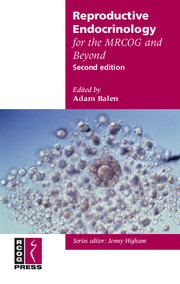Book contents
- Frontmatter
- Contents
- Acknowledgements
- Preface to the first edition
- Preface to the second edition
- Abbreviations used in this book
- 1 Sexual differentiation: intersex disorders
- 2 Adrenal disorders
- 3 Normal puberty and adolescence
- 4 Abnormal puberty
- 5 The menstrual cycle
- 6 Disorders of menstruation
- 7 Amenorrhoea
- 8 Polycystic ovary syndrome
- 9 Health consequences of polycystic ovary syndrome
- 10 Anovulatory infertility and ovulation induction
- 11 Lactation and lactational amenorrhoea
- 12 Hyperprolactinaemia
- 13 Thyroid disease
- 14 Diabetes
- 15 Lipid metabolism and lipoprotein transport
- 16 Premature ovarian failure
- 17 Calcium metabolism and its disorders
- Appendix: Endocrine normal ranges
- Further reading
- Index
17 - Calcium metabolism and its disorders
Published online by Cambridge University Press: 05 August 2014
- Frontmatter
- Contents
- Acknowledgements
- Preface to the first edition
- Preface to the second edition
- Abbreviations used in this book
- 1 Sexual differentiation: intersex disorders
- 2 Adrenal disorders
- 3 Normal puberty and adolescence
- 4 Abnormal puberty
- 5 The menstrual cycle
- 6 Disorders of menstruation
- 7 Amenorrhoea
- 8 Polycystic ovary syndrome
- 9 Health consequences of polycystic ovary syndrome
- 10 Anovulatory infertility and ovulation induction
- 11 Lactation and lactational amenorrhoea
- 12 Hyperprolactinaemia
- 13 Thyroid disease
- 14 Diabetes
- 15 Lipid metabolism and lipoprotein transport
- 16 Premature ovarian failure
- 17 Calcium metabolism and its disorders
- Appendix: Endocrine normal ranges
- Further reading
- Index
Summary
Calcium plays an essential role in homeostasis. Serum levels of calcium are precisely controlled, principally through the actions of parathyroid hormone. Serum calcium is in a dynamic equilibrium with that bound to plasma albumin and that in bone as hydroxyapatite. The main sources of calcium in the diet are milk, cheese, leaf and, in particular, root vegetables, nuts, greens and ‘hard’ water. Absorption from dietary sources is inefficient, compounded by up to 1g faecal loss and up to 500 mg urinary loss daily. Calcium absorption is reduced by oxalates in leaf vegetables and phytates in wholemeal flours and is increased by aciduric meat-derived protein, while urinary secretion is enhanced by high dietary sodium and reduced by potassium. The biochemistry of phosphorous is intimately involved with that of calcium. It is lost from the renal tract in exchange for calcium recovery under the influence of parathyroid hormone. The daily turnover of calcium is 25 mmol (25 mmol ingested in the diet, 20 mmol lost in the gut and 5 mmol lost in the urine). The turnover in bone calcium alone is 10 mmol per day from a total bone content of 25 mol (nearly 1300 g). In large part, the turnover of phosphorus mirrors that of calcium, with the larger proportion being lost from the kidney (40 mmol ingested, 15 mmol lost in faeces and 25 mmol lost in urine).
- Type
- Chapter
- Information
- Reproductive Endocrinology for the MRCOG and Beyond , pp. 189 - 196Publisher: Cambridge University PressPrint publication year: 2007



